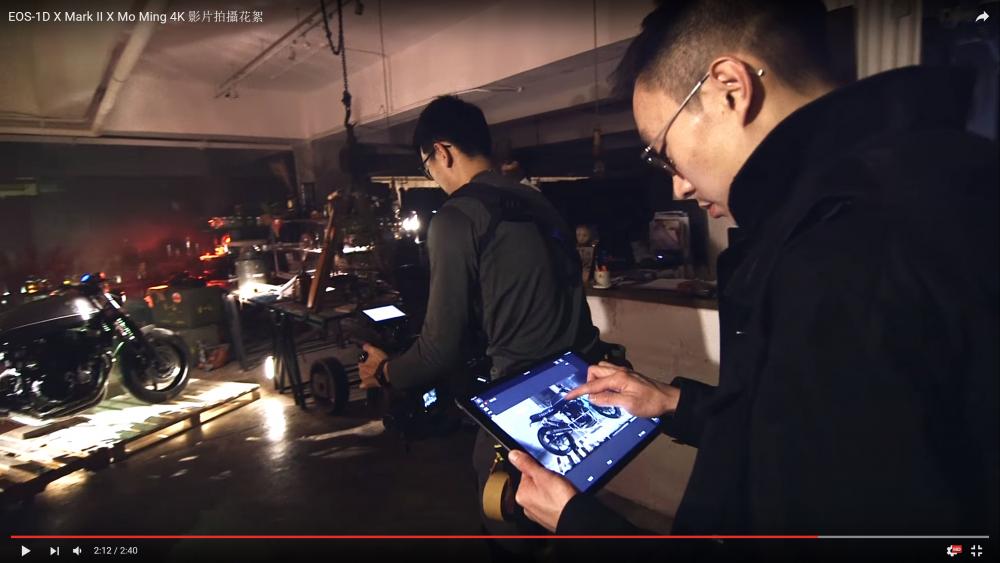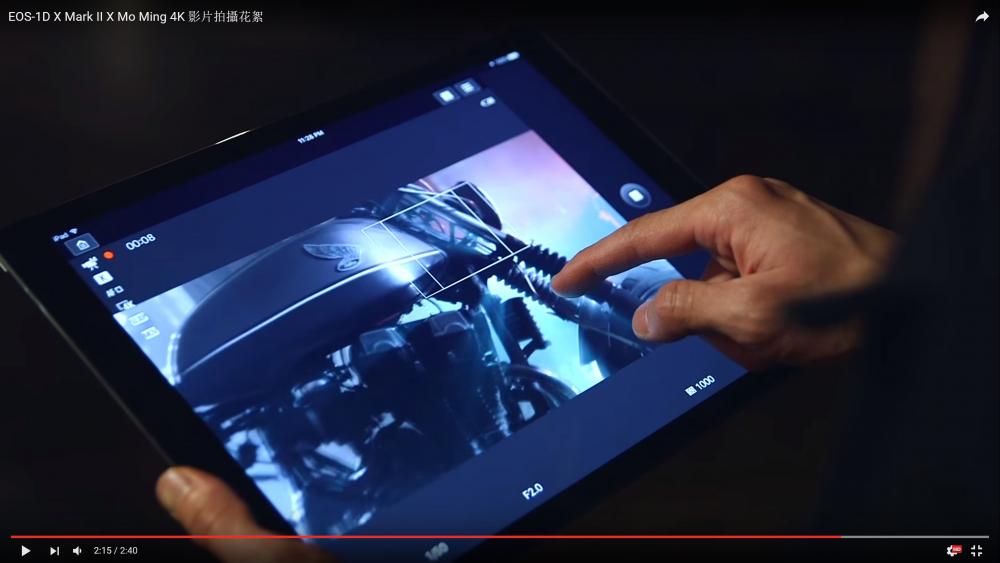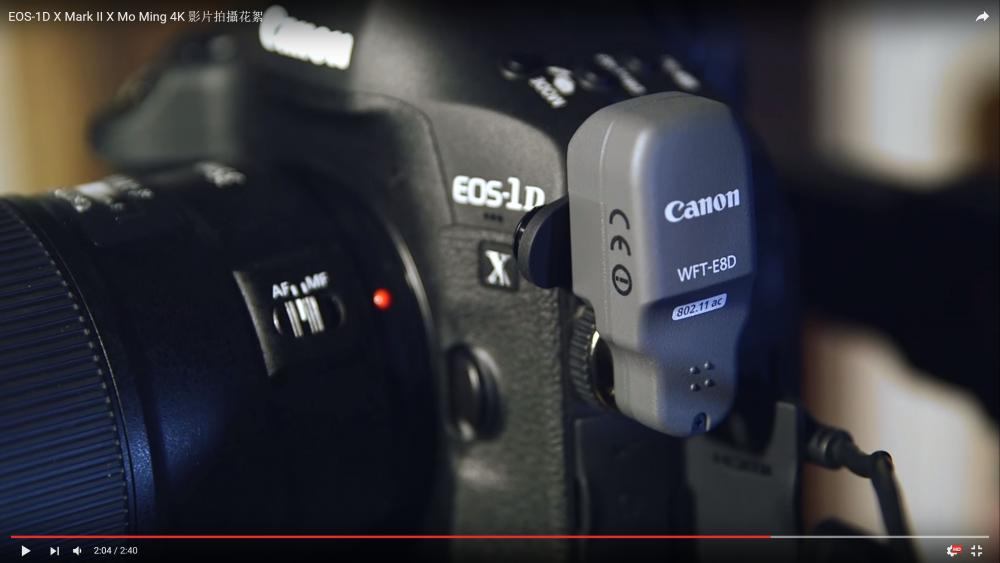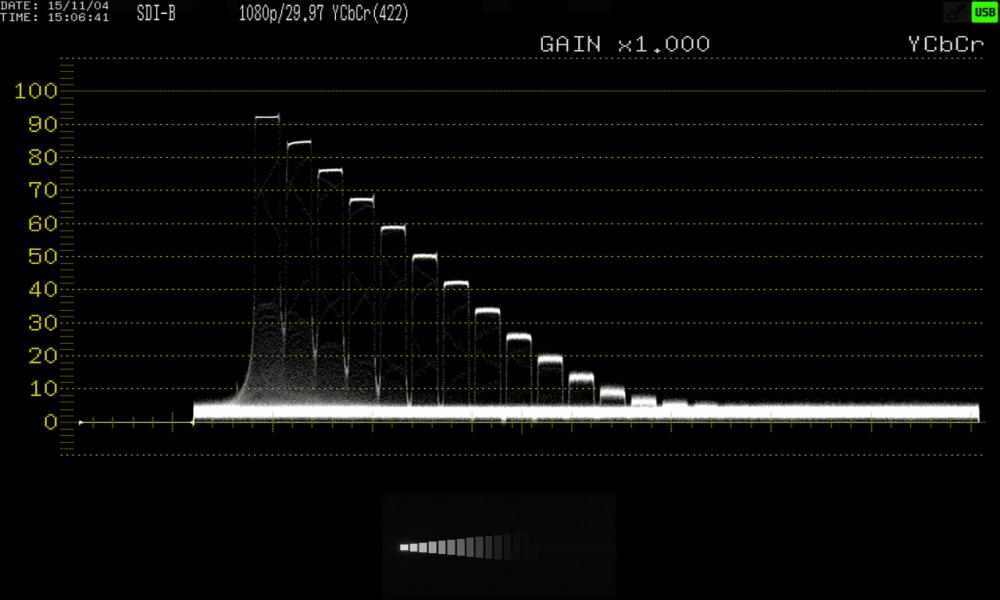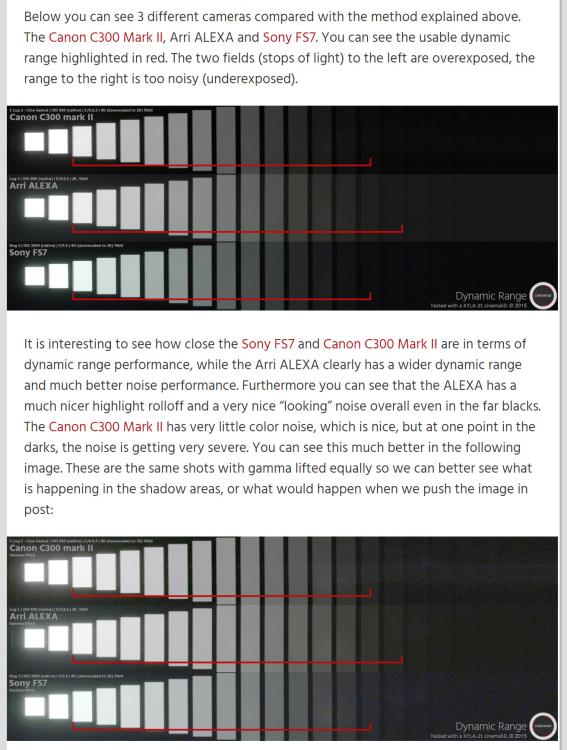
Kino
Members-
Posts
242 -
Joined
-
Last visited
Content Type
Profiles
Forums
Articles
Everything posted by Kino
-
No chance. C-Log is exclusive to Cinema EOS cameras and Canon camcorders (XC10). You will never see it on the 1DX II. The paid "firmware" upgrade will come with its own body in the form of the 1DC II. I think this is predictable market segmentation by Canon. In terms of video, the 1DX II only serves as a platform for a dedicated and much more capable cinema DSLR.
-
We've already addressed this user-made graph on the forum. It was posted by a regular forum member at fredmiranda.com and is not from any review site or reliable source: http://www.fredmiranda.com/forum/topic/1421137 It's also using the RAW files and not JPEG, which is more relevant to the MJPEG codec in the 1DX II and 1DC. The difference between neutral and C-Log on the 1DC is 3-4 stops. If, as this test shows, neutral is the same on both cameras, the 1DX II is shooting with a 3-4 stop penalty vs. the 1DC. I will leave it to other forum members to decide if this is significant or not based on their intended use. I think if you are shooting under artificial lighting (e.g., nighttime, studio filming) or overcast conditions, it's not as much of a problem since you don't need more than 9 stops of DR for these conditions. Another way to think about it is if 3 stops of DR, Super 35mm mode, and improved color grading are worth the extra $2,000 while sacrificing DPAF and beautiful 4K60p.
-
According to Mitch Gross of Convergent Design, FS700 RAW will provide the same quality as FS5 RAW as the RAW sensor data is exactly the same on the FS cameras. The sensor is also the same Sony Super 35mm used on the FS7, F5, and F55. The main difference is that the F5/F55 can record in 16 bit RAW, while the F55 has the global shutter that has already been mentioned above. Personally, if I had to choose among the FS cameras, I would still go with the FS7 for its internal XAVC 10 bit 4:2:2 S-log3 as it provides more dynamic range than 12 bit linear RAW from the same sensor. Of course, if you have the money, the F5 is a masterpiece and the only camera you will ever need in the 4K era. But used prices are never much lower than brand new. When you think about it, at $16K it's only $1K per bit!
-
I feel like RED went in the wrong direction after the Epic 5K sensor, which had larger photosites than Dragon (5.4 vs. 5.0 µm). While I love the color you get from the Dragon, and have put in an order myself for the Raven (which I'm likely to switch to Scarlet-W, as it is the sweet spot for price/performance in RED's lineup), there is no comparison between Dragon and Alexa when it comes to ISO performance at 800: Of course, the Alexa can be noisy as well (e.g., Lubezki's Birdman had excessive noise in the shadows as much of the film was shot in near darkness), and its resolution is not ideal for 4K release, but its lowlight performance is far superior to the Dragon, which gets very noisy above ISO 1600. The 6K resolution does minimize this noise pattern better than the same Dragon sensor at 4K, but it's still very noticeable on a lot of 6K lowlight footage that I have seen.
-
This is precisely what I have been saying. RAW definitely has an advantage in post, but a camera's color science is far more important than the fact that it shoots in RAW. This why so many 8-bit Canon cameras look so good when it comes to skin tones or true-to-life color capture. It's also why RED cameras have such an advantage over BMD, despite the fact that they both give you 12 bit RAW.
-
Ebrahim, Why stop at 14 bit? Surely, the Sony F5 is "better" with true 16 bit RAW. I'm sorry, but paper specs mean nothing to me, just as if you put the FS7's 10 Bit 4:2:2 S-log3 image next to the 12 bit RAW you get from the same sensor in the FS7 or FS700, you will see that the S-log3 image has far more dynamic range. Not all RAW is created equal and the implementation of RAW can vary dramatically from one camera to another. The 1DC 4K image in C-Log is for me the most amazing video image I have ever seen from a DSLR. Perhaps the Leica SL with its 10 bit 4K 4:2:2 external will give it a run for its money as it also has Log, but I've barely seen any footage from that camera at all. The 5D 2K RAW is fine for HD applications. However, I would never choose that above the 4K 1DC. For future proofing, at the very minimum you must shoot in 4K nowadays. My personal view is that my next camera should shoot in 5K (for effective downsampling to 4K, as a CMOS Bayer sensor should only be rated at 75% of its listed resolution) or that it should resolve an amazing level of detail in 4K such as with the 1DC and 1DX II.
-
I think it is ironic that these jokes about the Nazis and MF are actually true. The famous Arriflex 35 that became a standard film industry camera after WWII originated in Nazi Germany. It was the first 35mm motion picture camera to allow for reflex focusing. So, yes, when it comes to motion picture cameras, the Nazis perfected manual focusing. Still, I prefer the precise control of MF for hand-held documentaries, even if it makes me a bit of a camera "Nazi." Here is an example of the 1DC in a documentary setting that shows the value of manual focusing for stylistic effect:
-
All this discussion about handheld documentary shooting is really failing to identify the revolutionary nature of DPAF technology as implemented in the 1DX II. Certainly, achieving critical focus in split-second time and undertaking rack/follow focus will be much easier with DPAF than any manual method, even with a great monitor that has focus peaking. But the truly impressive capabilities of DPAF that would be very costly if not impossible to emulate through any other means include remote focus control and completely autonomous focusing. For me, the fact that DPAF can keep focus on a moving or stationary subject as I perform a tracking or stabilizer shot is priceless. Moreover, the touchscreen focus control is also accessible through a WiFi tablet application that has a range of over 300 feet. The Mo Ming BTS video in particular demonstrated this ability to control focus pulls remotely during live shooting (using the optional $600 WiFi unit):
-
I agree 100%. But ask yourself why Canon has deliberately made this a "miserable choice"? They could have made this an easy choice by adding one or two features to the 1DX II, but they didn't. It's part of their incremental product advancement and segmentation. It's similar to what Sony has done with the A7RII and A7SII by giving them different features and by designating one camera an all-round high-resolution "hybrid" and the other a low-light video/photo shooter. It's also why I firmly believe there will a 1DC II announcement later this year that puts an end to your "miserable choice." They are not going to drag this thing out for too long as the competition is really intense in this sector and so many have already left Canon for other brands. Now what would be really "f***ing amazing" would be the adoption of JPEG 9 in the camera's photo mode so as to allow for higher bit depth (the new JPEG spec can go up to 12 bit) in a new and redesigned MJPEG engine.
-
That's all kinds of horseshit. Based on what, youtube videos of flowers? A building? The issue has nothing to do with the 1DC per se. Focusing the 1DC is not very different from any film/video camera up to this point...until Canon's dual pixel cameras and the 1DX II. You're losing sight of what the 1DX II offers. No, it's not difficult to focus any lens if you have a good focus puller. Or if you have the budget for one. Or the space in a location for one. Have you seen the 1DC used as a documentary camera? Have you seen it used to capture live events? How about feature films? And of the latter, how many of them were shot with a single operator? Meanwhile, the 1DX II provides solutions to all of the above. That's an advantage in time, efficiency, money, and creative opportunity. I'm not saying the 1DC doesn't have a dynamic range advantage. If that's the criterion for your camera, then that's your personal preference. But saying the 1DC isn't hard to focus is socking the straw man. I'm not sure how my statement on the focusing the 1DC could be interpreted as a slight on the 1DX II. Some people mount an external monitor such as the SmallHD 502 on top of the 1DC and that makes focusing much easier while adding a whole bunch of monitoring tools that are missing from the 1D series. Moreover, a lot of documentary content has been shot on the 1DC with a single operator, some of which I have already reference in this thread (e.g., the National Geographic series Tales By Light). Narrative is another matter, as most of these productions have larger crews and assistant camera people. I do not underestimate the 1DX II one bit as you seem to underestimate the 1DC's extensive deployment in film and TV production. Its credit list is much longer than you might think and it is still the only DSLR to be EBU certified for Tier 1 HD broadcast in Europe. This means that 100% of broadcast content for any show can originate on the 1DC: http://cpn.canon-europe.com/content/news/eos_1d_c_gains_ebu_approval.do DPAF looks pretty awesome to me. The 1DX II also has a higher resolution rear screen that makes it easier for manual focusing. These are all great shooting tools, as is the audio line in which wasn't added in the 1DC until a later firmware. The 1DX II's greatest feature that sets it apart is the 4K60P, which produces beautiful slow motion as in the example I linked to above. Despite all these advantages for the 1DX II, if I had a choice between these two cameras, I would definitely choose the 1DC as its image is more appealing to me by a significant margin.
-
I don't think you have to worry about another $12K 1DC. Canon has already learned its lesson on that one. I'm pretty sure 10 bit internal is impossible on these weather-sealed bodies with the current sensor and heat management technology. That's why a 1DC II would be much closer in price to the 1DX II because the only advantages would be a few cinema features such as C-Log and possibly Super 35mm mode. $8,000 would be the realistic price of the 1DC II, as Canon has already demonstrated the ability to bring the 1DC technology to the market for only $6,000 in the 1DX II. I also don't think they will ever put C-Log in the 1DX II as it would disrupt their entire Cinema EOS line. Moreover, the 1DX II price point and its place in Canon's market segmentation was determined by their primary competition: the Nikon's D5 at $6500. So they couldn't retail the 1DX II for a higher price in order to add the features they are going to include with the 1DC II. This way, by maintaining separate 1DX and 1DC lines, they retain segmentation while competing effectively with the Nikon D5.
-
The "cinematic" or "filmic" look is definitely too broad a concept, which is why I suggested considering the 1DC and 1DX II as two different kinds of film stock: one has softer roll-off, more DR, and a wider color gamut (owing to the advantages of grading with C-Log) and the other has abrupt roll-off, less DR, and a more limited but "vivid" color palette. Neither one is less "filmic" than the other since you can find many historical film stocks that mimic each one of these cameras. Of course, I prefer the first option, and I can't imagine that focusing is all that difficult on the 1DC considering the number of incredibly sharp images I have seen from that camera. And I don't think anyone who buys a 1D series camera for video wants a "proper video camera." That defeats the whole purpose. The form factor, weight, and ease of use alone provide so many advantages that make these cameras essential for some shooters. Besides, I prefer the 1DC's resolving power, 1.3x crop factor, colors, image depth, and highlight roll-off to pretty much everything I have seen from cameras like the Mini 4.6k, Sony FS7 and even the RED Raven that I have ordered (but may cancel or switch to Scarlet-W). And you can't even compare Canon's space-age manufacturing facilities to BMD's amateur and fourth-rate quality control.
-
Not in camera, as you would obviously lose stops in the highlights. A 6dB and 12dB gain were applied to the C300 II files in post to achieve those results: https://tech.ebu.ch/docs/tech/tech3335_s18.pdf Roberts is one of the greatest broadcast and video experts on planet earth and his camera tests are always highly informative. I'm sure he knows what he is doing, even though some of it seems like Voodoo to me.
-
Roberts's extensive test of the C300 II suggests that those stops are useful and can be recovered by boosting the gain. He also uses a different methodology to reveal the camera's true DR that a normal Xyla test would not reveal. It's all really impressive. I would certainly rank his test as far more comprehensive than Cinema5D's Xyla and IMATEST combo, so there will be no argument from me on that one. That guy is practically a genius. Maybe it is a 15-stop camera because of the C-Log2 implementation. That's exactly what his test demonstrates. Now imagine if we got C-Log2 and internal 10 bit recording on the 1DC II. I don't know if that's possible without a fan, something that is not going to happen on a weather-sealed body unfortunately. As for SNR conversion: 6dB = 1 stop.
-
Like DR, ISO performance is also a function of signal-to-noise, but they are separate things. A great low-light camera such as the A7S is not necessarily going to give you the greatest DR. The C300 II is a fantastic low-light camera (one of the best of the cinema cameras), but not necessarily the one with the greatest DR. There is no doubt that Alan Roberts is a star and helps to set EBU standards. I have the highest respect for him. You will note, however, that this was a test of the C300 II only and not a comparison: "Unlike other testers he does not do direct comparisons with other cameras. Each test stands on its own and comes with a set of recommendations for how users can set up the camera for good results. He tries 'to think like a normal user would think: What am I going to use this camera for? And how am I going to use it?'" You will also note the way in which he obtained these results: "Adding 6dB and 12dB gain confirmed that the dynamic range is indeed about 15 stops." That's fine and is something I mentioned above when talking about lifting the gain to obtain more DR. But you could do that with almost every camera and get more out of it, depending on your subjective standards of acceptable noise (yes, there is always interpretation involved in determining DR). I'm just not sure if it really changes the relative performance of the C300 II against the Dragon and Alexa, since those cameras all have different noise patterns and color performance when underexposed. It is also interesting that Roberts recommends shooting the C300 II in the HD 12 bit 4:4:4 mode for maximum performance.
-
Cinema5D uses IMATEST software to determine the "usable" DR from Xyla results, but you don't need that to see what the usable DR is in those C300 II results. You can see it for yourself on those Xyla charts where several bars in the range are useless because they are clipped or have too much noise to be counted as "usable" stops. It's really easy to see and does not make one "the dumbest person." Canon's response to the Cinema5D's assessment of 12 stops was not in the form of a Xyla where you can see noise patterns and clipping effects, but a waveform that they claim demonstrates 15 stops: Unfortunately for Canon, this waveform actually confirms that the C300II does not have 15 stops usable as the last 3 stops are completely useless. The problem here is that the last few "stops" you are looking at are differentiated by voltage differences that do not rise above the noise floor: https://***URL not allowed***/canon-measured-15-stops-dynamic-range-c300-mark-ii/ Moreover, Canon lists the C300 II's signal-to-noise at 67dB, which translates into 11 stops! That's about as damning as you can get. RED Dragon by contrast is listed at 80dB (which equals 13 stops not 16.5 as RED claims). That's a vast difference.
-
A retail price drop will affect the used price as well. And, unlike most cinema cameras, the 1DC has no sensor remapping function built into the camera so just make sure there are no bad pixels on any used unit you are looking at. The only way to fix it at that point is to send it back to Canon, which might get costly without a warranty.
-
Hurling insults isn't going to advance your argument, or make you seem particularly logical, composed, and mature. Are you here to debate people in a civil way or to insult them? We've been through the charts a million times. As I noted before, Xyla tests are up for interpretation and are not scientific. Acceptable levels of noise vary depending on who is undertaking the testing. What Cinema5D is doing is applying IMATEST software to the results to come up with one standard however arbitrary it may be to you or me. Then that standard is applied universally to all cameras so that they can all be compared against one another in an objective way. Moreover, their results are mostly consistent with DR tests from other sources such as the Hurlbut tests I posted above on the 1DC. You are free to believe whatever Sony and Canon state, but that doesn't mean that manufacturer claims are credible or that they can demonstrated through independent tests such as those undertaken by Cinema5D. I for one appreciate independent tests undertaken by industry technicians who provide the evidence to back their results more than baseless claims from a camera company's marketing department.
-
No one is stopping you from making completely false comparisons . . . Misinterpreting or misrepresenting DR numbers from a Xyla chart is far from arguing that the "earth is flat." That's just nonsense! We are talking about a difference of a few stops between manufacturer claims and actual DR performance in terms of "usable" stops. Besides, Cinema5D is independent of those manufacturers who routinely exaggerate their DR claims, which can be off by 2-3 stops as demonstrated by the C300 II and FS7 Xyla charts above. As for Arri, they generally don't advertise DR numbers for their cameras, even though the Alexa is shown as the best performer in Cinema5D's Xyla tests. I don't think there is any controversy in that at all.
-
Ebrahim, We could be here all day talking about testing methodology for DR, but life is too short. As I mentioned, Cinema5D's methods are not perfect because even IMATEST has to make arbitrary decisions about what level of noise or clipping is acceptable when determining steps of DR. Even so, once that methodology is applied universally to all cameras that they test, it provides as good a picture as any of which cameras have a greater or lesser range. Perhaps the 5DIII/C300 example is an anomaly, but we don't have all the data in front of us to make that determination. I just like the fact that their Xyla charts expose a lot of manufacturer (and fanboy) claims about certain cameras. Soon enough, BMD's claims about "15 stops" on the 4.6k will meet Cinema5D's Xyla-IMATEST combo. The results won't be pretty. So I think it's great that Cinema5D causes controversy because that tells me they are doing their job correctly by offending a lot of people who should know better than to believe manufacturer fictions on DR. As for the 1DX II, it's a camera to recommend more for function than cinematic image quality, which is not its forte. All the same, I think it would be a great documentary, corporate, travel, or event video camera, especially in shooting conditions that don't call for a lot of DR.
-
You, me, and everyone else! I check the 1DC price twice daily and it hasn't moved in months. I read that B&H had a flash sale at $6500 or $7000 at the end of 2015 but I haven't seen anything like that since. I don't expect that the retail price will move until we are closer to the 1DC II announcement.
-
So getting back to the main topic of this thread, here is some great 4K 60fps slow motion from the 1DX II: The performance of the 800 Mbps MJPEG is just astounding here in terms of the detail you can see in the image. It's a very high-quality slow motion with perfect motion cadence. I guess it better be at 100 MB/s!
-
The standard is Alexa, they advertised 14 stops and the test proved it. If you must say C300 has more than 12 stops, than Alexa can do 15 or even 16, but ARRI decided on 14 based on years of research and strict standards. 12bit RAW does not increase dynamic range, and it does not make any part of it "more usable". SNR is affected by sensor characteristics and compression, not quantisation. You must have missed the part where I said that Canon's claim of 15 stops is "false" because it would put the C300 II above the Alexa. I thought I was pretty clear on that. Cinema5D's Xyla test clearly showed the Canon as behind the Alexa and on par with the FS7 at 12 stops "usable" based on their methodology. I also never said that RAW "increases" dynamic range only that it allows for better recovery of the highlights and shadows in post depending on your camera. On the BMPC-4K, this is very much the case as RAW maximizes the available DR from the sensor when you compare CDNG and ProRes files in Resolve. But it should be pointed out that RAW implementation simply does not behave the same on all cameras (e.g., Log vs. Linear) to make any generalizations about what it might do to the camera's potential DR as Sony FS7 owners were unfortunate enough to learn when they paid thousands of dollars to add a RAW "upgrade" that was really a downgrade in DR when compared to the camera's internal 10 bit 4:2:2 S-log3.
-
You will notice that I made the distinction between visible and usable DR. The Xyla test reveals the entire "visible range," but Cinema5D's conclusions on DR are generally based on the "usable range," which can be reduced by 1-2 stops (especially with RAW). That's what I'm referring to as the recoverable DR that Cinema5D does not include in its DR ratings. You can see this on their Xyla tests as the difference between all the steps the camera records and the red line that marks what they accept as "usable" DR. They even lift the gamma to expose this expanded range that is accessible in post. On the C300 II, they counted only 12 steps (13 bars) of usable DR, whereas the visible DR range goes beyond that by several stops. Also, the C300 II was tested in its internal 10 bit 4:2:2 codec, where it achieved 12.3 stops of DR on IMATEST. However, using 12 bit RAW one would assume a slightly greater DR and a more usable range. They did not test the camera using its 4K 12 bit RAW output. They claim to have tried it out on 2K 12 Bit RAW but do not post the results as, according to them, it was no different from the 10 bit file. Ultimately, a Xyla test is just another test with variables that can affect the outcome, including the acceptable level of noise or clipping that one interprets when counting steps. Using IMATEST just guarantees that all camera results are treated equally and can be compared against one another. IMATEST is not some higher standard of DR "precision." It still has to make a quantitative assessment of acceptable noise and clipping levels. Yet there is no universal or scientific standard for noise performance. What is acceptable to one person may not be to another.
-
The C300 II Trick Shot video is actually a pretty amazing demonstration of DR and color. It just shows you what you can do with C-Log2 even in a compressed 10 bit 4:2:2 codec. This is why it is so important that the 1DC has C-Log. It makes an 8 bit camera act like 10 bit, while a 10 bit camera acts like 12 bit. That's the magic of a good Log implementation. Cinema5D's methods certainly leave something to be desired as they switch between talking about "visible DR" and "usable DR" in the same review or across reviews. They never posted a 1DC Xyla, but claim that both the C300 I and 1DC achieve around 10-11 stops of "usable dynamic range," without noting whether they employed C-Log (I would imagine they did): https://***URL not allowed***/dynamic-range-sony-a7s-vs-arri-amira-canon-c300-5d-mark-iii-1dc-panasonic-gh4/ Personally, I find Hurlbut's over-and-under tests of the 1DC and C500 to be a far more valuable indication of DR. His series of tests with the C500, the Alexa, and RED Dragon are also very impressive in terms of what they reveal about the C500 as a camera that surprises with great color and low-light performance: What I mean by "RAW recovery" is simply what happens when you go into Resolve and use highlight and shadow recovery to extract more DR in the RAW file that you otherwise would not see if you are just looking at the ungraded image. Xyla tests such as the one used by Cinema5D do no represent that extended range, so we could add at least an estimated 2 stops to their results for RAW-capable cameras like the C300 II. Note that there is nothing scientific here about how many stops you can recover. It's just an estimate, but that is certainly the way it works with the CinemaDNG files from my BMPC-4K when I take them into Resolve. I recall that Cinema5D rated the BMPC-4K at 9 stops whereas using Resolve you can lift the shadows at least one stop and recover highlights by at least a stop. Thus, the recovered DR is closer to 11 stops. As for the Sony F5/F55, it outputs true 16 bit linear RAW . . . no contest there. It's pretty much the king when it comes to RAW bit depth. Even RED R3D files offer only "16-bit precision" while Alexa and Ursa 4.6k use Log to achieve greater a bit depth that they don't actually record.


